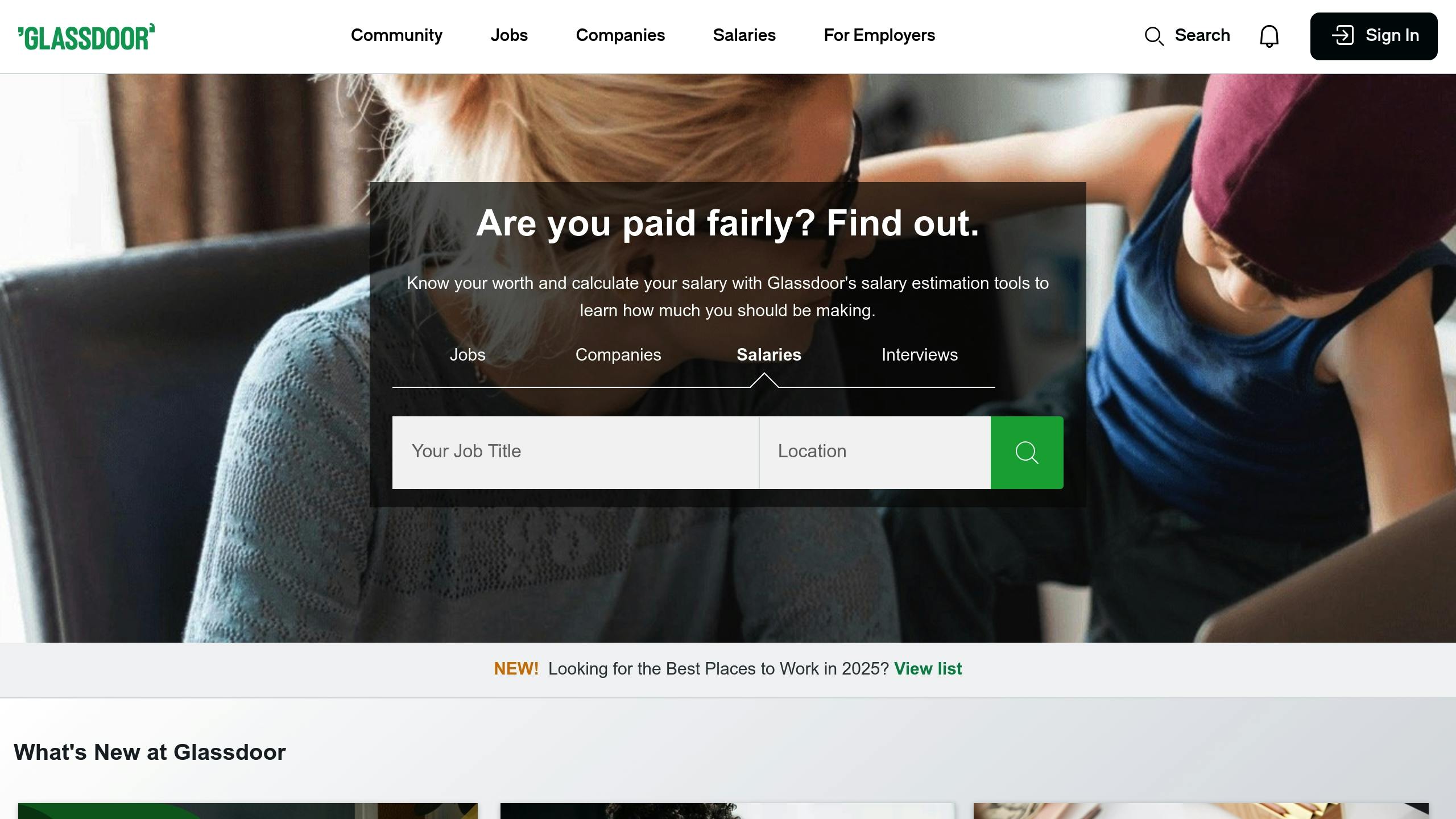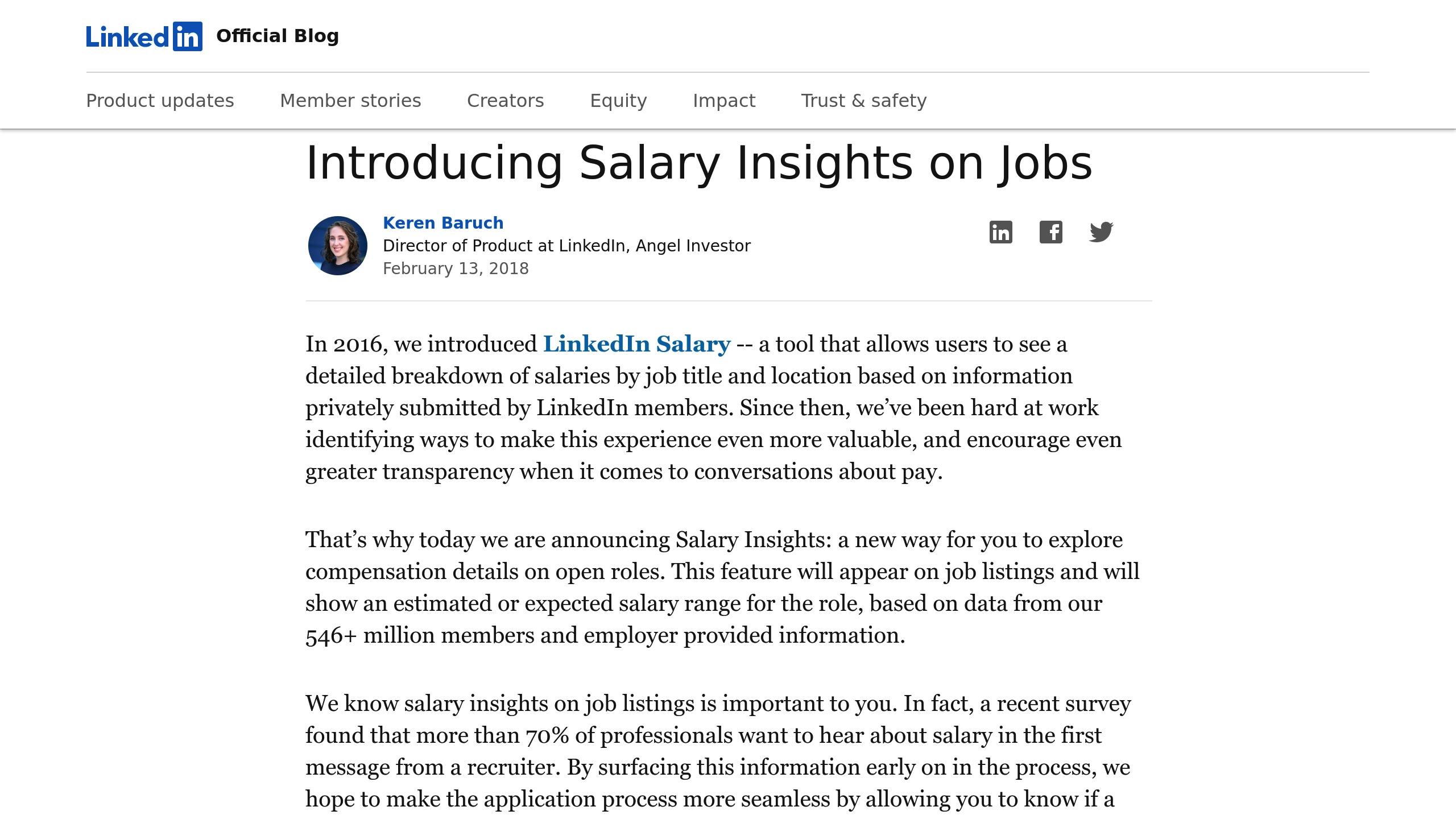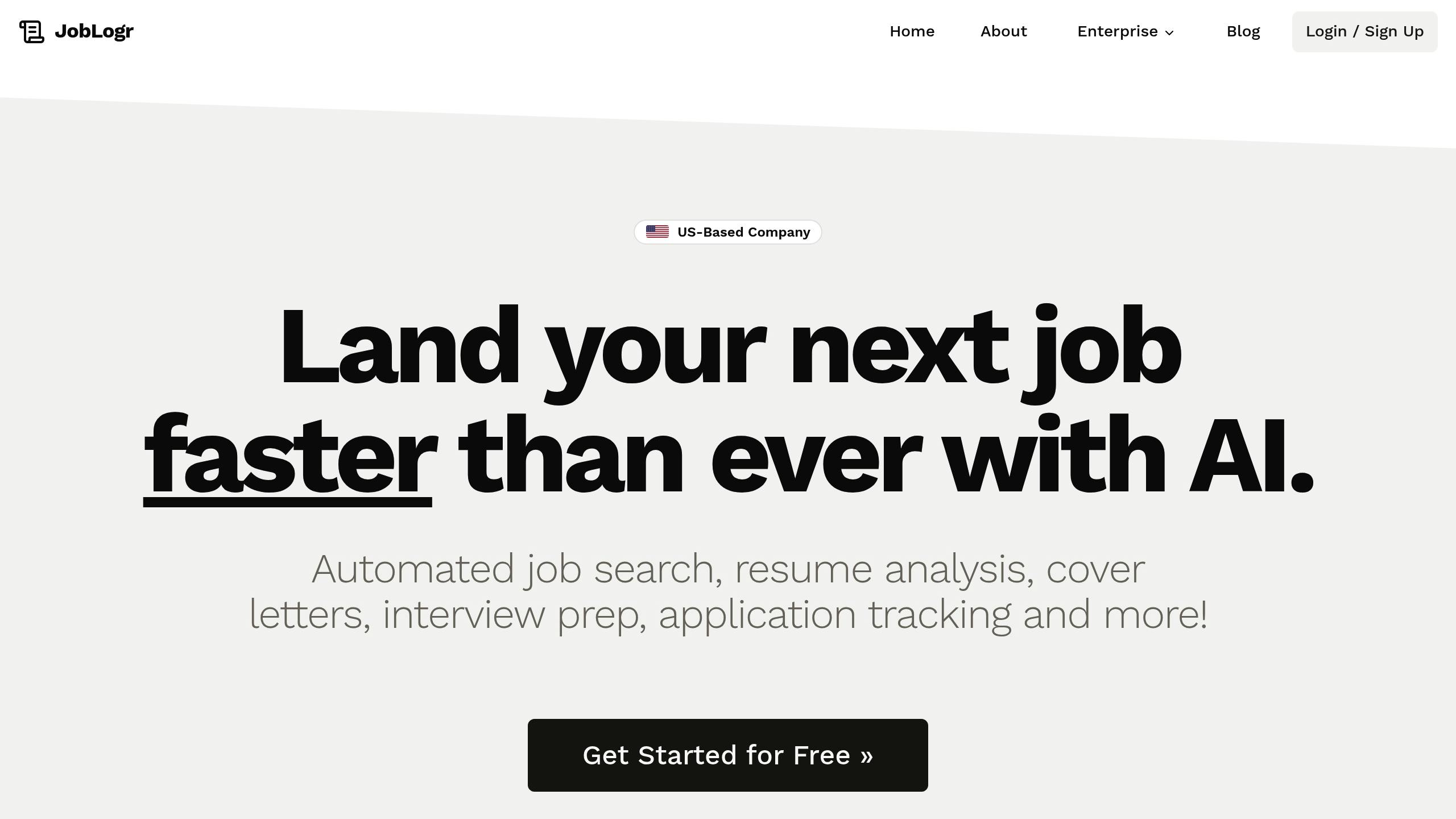
Salary Benchmarking Tools: Pros and Cons
Looking for the best salary benchmarking tools? Here's a quick guide to help you decide. Salary tools are essential for hiring and career planning, offering data on pay ranges, trends, and market comparisons. This article reviews four popular options: LinkedIn Salary Insights, Glassdoor, Ravio, and JobLogr, covering their features, pricing, and limitations.
Key Takeaways:
- LinkedIn Salary Insights: Accurate salary ranges tied to professional data, starting at $39.99/month.
- Glassdoor: Crowdsourced salary insights with company reviews, free with premium plans up to $399/month.
- Ravio: Real-time payroll integration for precise benchmarking, tailored pricing.
- JobLogr: AI-powered job search with basic salary trends, free or $20/month for premium.
Quick Comparison:
| Tool | Data Source | Key Features | Pricing | Best For |
|---|---|---|---|---|
| LinkedIn Salary Insights | Verified user data | Salary ranges, skill-building | $39.99–$170/month | Professional trends |
| Glassdoor | Crowdsourced data | Salary + company reviews | Free–$399+/month | Workplace insights |
| Ravio | Payroll system data | Real-time updates, automation | Custom pricing | Precise benchmarking |
| JobLogr | Job postings | Job search + salary trends | Free–$20/month | Job seekers tracking salaries |
Choosing the right tool depends on your needs: For real-time accuracy, go with Ravio. For crowdsourced insights, try Glassdoor. LinkedIn is great for professional trends, while JobLogr helps job seekers track opportunities. Dive in to learn more about each tool's pros and cons.
LinkedIn vs Glassdoor: Platform Comparison for Salary Insights

1. LinkedIn Salary Insights

LinkedIn Salary Insights is a premium tool within the LinkedIn platform that collects and analyzes salary data. It provides detailed pay ranges based on factors like:
- Job title and location
- Years of experience
- Industry and company size
- Education level
Studies indicate that LinkedIn's salary data is typically within 10-15% of figures from other trusted salary surveys [1][4]. This level of accuracy is due to LinkedIn's robust data validation and its professional user base.
Pricing:
- $39.99/month for job seekers (Premium Career)
- $170/month for recruiters (Recruiter Lite)
LinkedIn ensures anonymity, sets minimum submission thresholds, and adheres to GDPR by using aggregated reporting [1].
Limitations to Consider:
- Limited data for niche roles or rural areas
- Possible biases in self-reported information
- Delays in reflecting fast-changing market trends [1][4]
This tool is seamlessly integrated into LinkedIn, showing salary ranges on job postings and recommending skill-building courses via LinkedIn Learning [1][8].
"LinkedIn's salary accuracy stems from verified member data integrated with job postings", as noted in platform analyses [4].
Though LinkedIn leverages machine learning to improve its salary estimates, the platform doesn’t disclose how often these updates occur [1]. Its approach, based on verified data, sets it apart from crowdsourced platforms like Glassdoor, which will be discussed next.
2. Glassdoor
Glassdoor is one of the largest platforms for salary comparisons, offering over 100 million company reviews and salary reports from more than 2.1 million employers across 190 countries [2]. Unlike LinkedIn, which focuses on professional-network-driven data, Glassdoor pairs salary insights with anonymous company reviews - making it a go-to resource for informed career decisions.
Key Features and Accuracy
Glassdoor collects salary data directly from users and verifies it using advanced validation tools. Their machine learning algorithms filter out potentially fake submissions [5], ensuring salary estimates maintain a 95% confidence level [5]. Studies show that around 70% of Glassdoor's salary estimates are within 10% of actual salaries [1][2].
The "Know Your Worth" tool offers personalized salary estimates based on:
- Job title and location
- Years of experience
- Company size
- Industry trends
- Additional compensation details like bonuses or stock options
Pricing
- Free: Basic access for job seekers
- Premium: $14.99–$29.99/month for advanced features
- Employer Plans: $249–$399+ per month
Data Quality
Glassdoor ensures reliable data through methods like:
- Statistical tools to detect outliers
- User authentication to confirm data legitimacy
- Rolling averages to account for market changes [1][2]
Drawbacks
- Limited data for niche or highly specialized roles
- Some salary information may not reflect the latest trends in fast-changing industries
Users appreciate the combination of salary insights and company reviews, though the freshness of data can vary depending on the sector.
While Glassdoor blends workplace insights with salary data effectively, emerging platforms like Ravio are exploring more automated approaches to analyzing compensation.
3. Ravio
Unlike Glassdoor, which depends on user-reported data, Ravio connects directly to company payroll systems for a more accurate and up-to-date approach.
Why Real-Time Data Matters
Ravio stands out by integrating directly with payroll systems, ensuring real-time updates to compensation data. This solves the common lag issues seen in traditional salary surveys and tools like Glassdoor. The platform's automation reflects the growing trend of using AI-driven solutions in the industry.
Key Features
- Covers data for over 1,000 job roles across various industries [8]
- Direct integration with payroll systems
- Automatically matches job levels
- Offers industry-specific filters and peer comparison tools
Data Accuracy and Security
- Regularly updated data [2]
- Automatic job level mapping
- Ongoing data validation processes
Ravio also delivers detailed compensation insights, including bonus structures and equity breakdowns [2][3].
Pricing
Ravio uses a tailored pricing model based on the size and specific needs of each organization [8].
Drawbacks
- Pricing requires consultation with the sales team
- Limited access to historical data
This real-time model sets Ravio apart from tools like LinkedIn Salary Insights, which often struggle to keep up with rapid market changes.
sbb-itb-6487feb
4. JobLogr

JobLogr stands apart by using AI to streamline job searches instead of focusing on salary benchmarking like Ravio. While not a compensation analysis tool, it complements salary research platforms by providing insights from job postings [2][5].
Core Features
JobLogr’s AI helps automate job searches and tracks applications. It also pulls salary ranges from job postings, offering a basic glimpse into compensation trends. However, it doesn't include tools for in-depth salary analysis [2][5].
Pricing Options
- Free Tier: Includes basic job search and application tracking features.
- Premium Tier: Costs $20/month and unlocks the full suite of features.
Integration Limitations
JobLogr operates as a standalone tool and does not connect with payroll systems or HR platforms [3].
This makes JobLogr a helpful addition for job seekers but not a replacement for platforms focused on detailed salary benchmarking [8].
Benefits and Limitations
When comparing free and paid compensation tools, three main factors stand out: data quality, update frequency, and compliance measures.
Data Accuracy and Reliability
Paid platforms typically deliver more precise data by connecting directly to verified payroll systems and using structured verification methods [4].
Real-Time Data Updates
Paid tools often update information daily or weekly through direct system integrations [2][3]. In contrast, free tools may lag behind, offering outdated data due to inconsistent refresh schedules [1].
Operational Impact
Enterprise users have reported hiring processes that are 25% faster when using automated compensation matching [8]. Paid tools also include features like pay trend forecasting, which free options generally lack.
Security and Compliance
Handling sensitive compensation data requires strong security measures. Paid solutions often come with advanced protocols to ensure data protection and compliance.
Customization and Analysis
Free tools usually offer basic filtering options, such as location-based data. Paid platforms, however, provide more detailed insights, like industry-specific breakdowns [3], making them ideal for organizations with complex compensation needs.
Ultimately, the decision between free and paid tools depends on how these factors align with an organization’s specific goals. Businesses in specialized industries often benefit from the deeper insights and flexibility provided by paid solutions.
Conclusion
Salary tools today range from free platforms like LinkedIn Salary Insights and Glassdoor to advanced, AI-powered systems. For small businesses and startups, free tools provide a good starting point for researching compensation. While these platforms offer useful data for market analysis, their self-reported nature means it’s important to cross-check information with multiple sources [1][8]. Tools like LinkedIn Salary Insights, Glassdoor, Ravio, and JobLogr each cater to different needs, making it essential to choose based on your specific goals.
For mid-sized and larger companies, paid solutions often provide better results, especially when managing more complex pay structures. Research suggests that premium platforms can speed up hiring cycles by 23% [7].
Ravio, for example, brings payroll integration and automated tracking to the table, offering features that align with the growing demand for data-driven compensation strategies [3]. These tools reflect a shift toward real-time data and AI-driven insights, which are becoming increasingly valuable in salary benchmarking.
Key factors to consider when choosing a benchmarking solution include:
- How current the data is
- Whether it’s tailored to your industry
- Costs of implementation
- Compatibility with your existing HR technology
Tools like Ravio and Glassdoor highlight the importance of blending real-time data with crowdsourced insights. As AI continues to evolve, expect salary benchmarking tools to offer more predictive analytics and personalized recommendations, helping businesses stay competitive in attracting and retaining talent [5][6].
Ultimately, these tools should support - not dictate - your compensation decisions, ensuring they align with your company’s broader goals and values.
FAQs
What is the best salary benchmarking tool?
The best salary benchmarking tool depends on your specific needs and priorities. Here's a breakdown of the tools analyzed - LinkedIn Salary Insights, Glassdoor, Ravio, and JobLogr:
- LinkedIn Salary Insights: Provides salary trends within professional networks and links to skill development resources.
- Glassdoor: Offers crowdsourced salary data along with company reviews to give a broader view of workplace compensation.
- Ravio: Features real-time payroll data and automated benchmarking for precise comparisons.
- JobLogr: Focuses on salary trends derived from job postings and includes application tracking.
If you're looking for real-time payroll data, Ravio stands out with its payroll integration and automated benchmarking. For crowdsourced insights, Glassdoor is a solid choice, while LinkedIn excels in showcasing professional trends. JobLogr is ideal for analyzing salary patterns from job postings and tracking applications [1][2].
Ravio's real-time data and JobLogr's job posting insights highlight two distinct approaches to researching compensation in today's job market [2][5]. Match the tool to your specific goals for the best results.